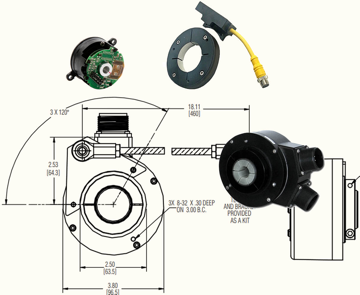You can calculate the number of shaft positions on your encoder with the following equation: 2x where X = the resolution of your absolute encoder in bits.
How Many Shaft Positions Exist on Absolute Encoders?
Posted by London Rhodes on Jul 29, 2021 10:33:47 AM
Topics: Installation, Absolute Encoders, Encoder Signals Output, Troubleshooting
What Should I Consider When Converting DC Tachometers to Encoders?
Posted by London Rhodes on Jul 29, 2021 10:27:16 AM
Topics: Installation, Troubleshooting
How Do I Convert Gray Code to Binary?
Posted by London Rhodes on Jun 18, 2021 12:55:57 PM
Topics: Installation, Encoder Signals Output
Is Shielded Cable Required?
Posted by London Rhodes on May 24, 2021 3:29:26 PM
The use of shielded cable is highly recommended. This is especially true for areas in which large amounts of electrical noise exist. If you are having any noise problems, or suspect that you might, then use a shielded cable.
Topics: Installation
What is the Maximum Length of Cable I Can Use on a Dynapar Encoder?
Posted by London Rhodes on May 24, 2021 2:46:50 PM
Many factors play a role in determining the maximum length of cable that can be used to connect the encoder to the controller. The largest problem with running long lengths of cable is that the cable becomes more susceptible to noise. This is due to the capacitance of the cable, the cable acting as an antenna, and the loss of power through the cable. The maximum distance of cable can be achieved by following some basic wiring principles. Do not run the cable near objects that create a lot of electrical noise. This includes AC motors, Arc welders, AC power lines, and transformers. Use twisted pair cabling when using the signal and its complement, and shielded cabling when running any type of signal. Use the highest voltage available for the output voltage. For example, if the encoder will output 5 to 24 volts, then use 24 volts. Use an Open Collector or Differential Line Driver output with a differential receiver (PM28S00) so that the maximum amount of current can be sink/sourced.
If you are using the encoder as an input to more than 1 controller, use a signal amplifier. This is also a good way to help increase the distance a signal can travel. Typical maximum distances for a Differential Line Driver are around 100 ft.or more when using a differential input, and for an Open Collector the distance is around 35 ft.
Topics: Installation, Encoder Signals Output, Troubleshooting
How Do I Choose the Pulses Per Revolution (PPR)?
Posted by London Rhodes on May 24, 2021 2:07:13 PM
When choosing the PPR value of the encoder, please keep a few simple rules in mind. Make sure that you do not choose a PPR that will cause you to exceed the maximum frequency of your controller or encoder. Try to choose a PPR that is close to the value you wish to display, this eliminates or reduces the need for a calibration constant. For example, If you wish to display 12 inches for every revolution choose a PPR of 12. If you wish to display 12.00 inches, choose 1200 PPR. However, do not make the mistake of forgetting the multiplication of the controller's input. Most controllers have X2 or X4 logic. If it is X2 logic, this would change your PPR to 600 for a 12.00 display; and the PPR would be 300 for X4 logic. These choices give you one pulse for every one unit of measurement desired. It is important to remember the frequency that your PPR will create. When choosing the PPR, do not choose one that will result in a higher frequency than the encoder can handle at your max. speed. The reverse is also true, do not choose too low of a PPR, that your controller cannot recognize the signal. Try to choose your PPR so that your calibration constant is between .5 and 1.
How do I set my Calibration Constant?
The calibration constant can be simplified by simply selecting the correct Pulses Per Revolution (PPR). Once the PPR has been selected or is known simply follow the formula presented in the Technical Manual. When choosing your calibration constant remember the closer to 1 the better. The value of the calibration constant is your best resolution per pulse of the encoder.
Topics: How to Choose An Encoder, Installation
What is the Most Common Cause of Encoder Failure?
Posted by London Rhodes on Mar 30, 2021 2:25:18 PM
The most common cause of encoder failure is a warped/ bent shaft that is no longer sitting on the bearings properly, an issue also referred to as shaft run-out. A warped shaft adds stress to the internal bearings and may lead to bearing failure and eventual overheating of the encoder. Avoid encoder failure by ensuring proper installation. However, if you suspect shaft run-out in your encoder, use a dial indicator to help confirm whether or not the shaft is misaligned.
Topics: Installation, Troubleshooting
How Far Away Can My Encoder be From the Drive?
Posted by London Rhodes on Feb 16, 2021 7:22:44 PM
There is no simple answer to the length of a drive distance for encoders. Dynapar offers many feature options for encoders. If one simply uses high grade Teflon coated cable instead of PVC, the capacitance decreases from 37pF/Ft to ~12pF/Ft, tripling the useful drive distance. This variation in drive distance is solely based on the type of connection wire implemented
Topics: Installation
Should I Connect My Case Ground?
Posted by London Rhodes on Feb 16, 2021 7:21:35 PM
Case ground conductor are the preferred grounding method for encoders. The function of the case ground differs from the cable shield, which also makes contact with the encoder connector.
Topics: Installation
